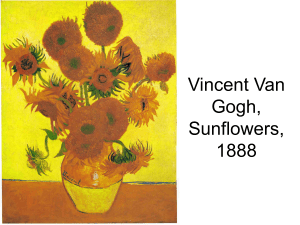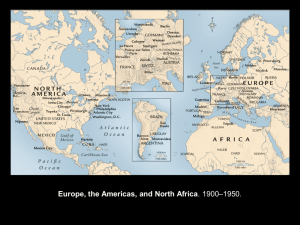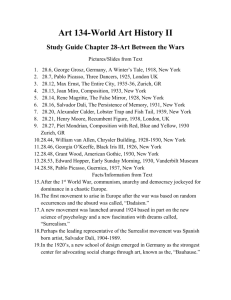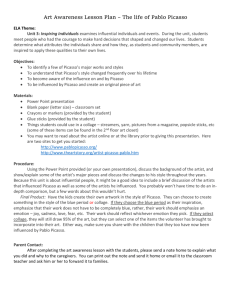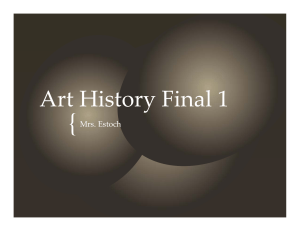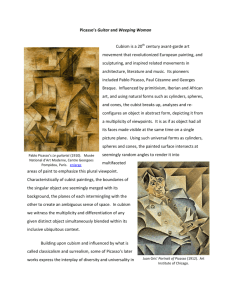Picasso Powerpoint
advertisement
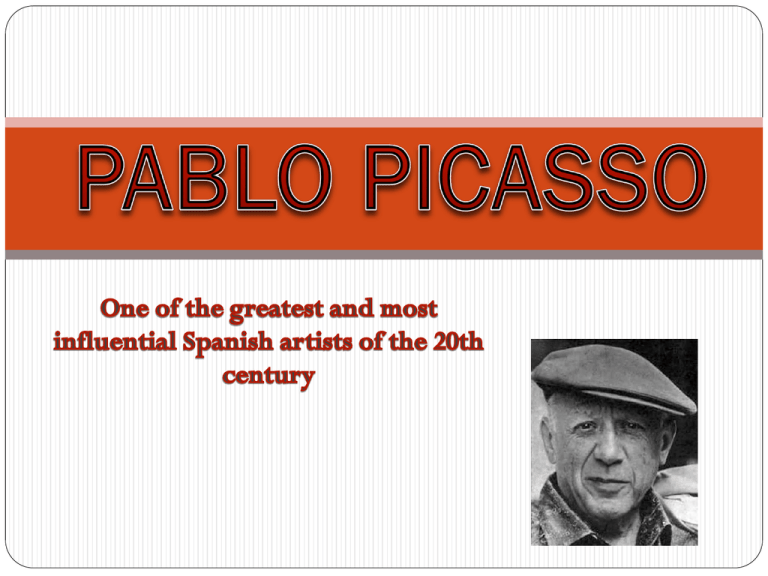
Pablo Picasso was born on October 25, 1881 in Malaga, Spain. He was the first child of Don Jose Ruiz Blasco, an art teacher, and Maria Picasso Lopez. At an early age Pablo showed an interest in drawing. His first words were "piz, piz", which is short for "lapiz", the Spanish word for pencil. At the age of 7, Pablo began receiving art instruction from his father. His father believed that an artist's training should include copying the masters and drawing the human body from plaster casts and live models. The precision of Pablo's painting technique grew until it soon surpassed that of his father. In 1895, Pablo's father accepted a position at Barcelona's School of Fine Arts. He asked officials to allow his son to take the entrance exam. The officials were impressed with Pablo's abilities and admitted him to the academy. As a student he lacked discipline but made friends and continued to grow as an artist. At the age of 16, Pablo's father enrolled him in Spain's most distinguished art school, Madrid's Royal Academy of San Fernando. However, his instruction at the Royal Academy lasted only a short time as he struggled to accept formal instruction. In spite of these difficulties, his time in Madrid was not wasted. Pablo visited Madrid's museums and saw the paintings of Diego Velasquez and Francisco Goya, though it was the works of El Greco that he admired most. In 1900, Picasso made his first trip to Paris. At that time Paris was considered to be the art capitol of Europe. While in Paris, Picasso's work began to attract the attention of art collectors. By 1905, he had become a favorite of American art collectors Leo and Gertrude Stein. It was through them that Picasso met French artist Henri Matisse. The two became lifelong friends In 1907, Picasso painted one of his most important works - Les Demoiselles d'Avignon, - creating with painter and sculptor Georges Braque the brand new art movement known as "Cubism". Pablo Picasso died on April 8, 1973 in Mougins, France. He is best remembered as the co-founder of Cubism, and for Cubist works Les Demoiselles d'Avignon (1907), Three Musicians (1921) and Guernica (1937). As a young boy, Pablo Picasso was a prodigy whose skills became an expressive power that profoundly affected the art of the twentieth century. The Blue Period (Spanish: El Periodo Azul) is a term used to define to the works produced by Spanish painter Pablo Picasso between 1901 and 1904, when he painted essentially monochromatic paintings in shades of blue and blue-green, only occasionally warmed by other colors. These somber works, inspired by Spain and painted in Barcelona and Paris, are now some of his most popular works, although he had difficulty selling them at the time. The blue period is a marvelous expression of poetic subtlety and personal melancholy and contributes to the transition of Picasso's style from classicism to abstract art. On an emotional note, melancholy and resignation best characterize Picasso's blue period. When Picasso's close friend Carlos Casagemas commits suicide, Picasso's trauma finds expression in a series of deeply sentimental paintings which comprise his blue period. The Blue Period work is quite sentimental, but we must keep in mind that Picasso was still in his late teens, away from home for the first time, and living in very poor conditions. The Rose Period started in 1904, a year in which Picasso alternated paintings in the "blue style", dark colored (often blue-ish) and downbeat, with paintings made in his "rose style", which are somewhat more optimistic in mood and brighter colored (often using the color pink). The Rose Period comes from the time when the style of Pablo Picasso's painting used cheerful orange and pink colors in contrast to the cool, somber tones of the previous Blue Period. The Rose Period lasted from 1904 to 1906. Picasso was happy in his relationship with Fernande Olivier whom he had met in 1904 and this has been suggested as one of the possible reasons he changed his style of painting. Harlequins, circus performers and clowns appear frequently in the Rose Period and will populate Picasso's paintings at various stages through the rest of his long career. The Rose Period is named after Picasso's heavy use of pink tones in his works from this period. By the middle of the Rose Period, Picasso’s paintings began to sell and he would never again have to suffer the hardship that he experienced in the earlier period. This may have been due to the nature of his works from this period. Although the structure was essentially the same (the figures still looking melancholy and the background still very simple), the change in colour, subject and brushstrokes make the paintings much more appealing. Cubism is an early-20th-century avant-garde art movement pioneered by Georges Braque and Pablo Picasso, joined by Jean Metzinger, Albert Gleizes, Robert Delaunay, Henri Le Fauconnier, Fernand Léger and Juan Gris, that revolutionized European painting and sculpture, and inspired related movements in music, literature and architecture. Cubism has been considered the most influential art movement of the 20th century. In Cubist artwork, objects are analyzed, broken up and reassembled in an abstracted form—instead of depicting objects from one viewpoint, the artist depicts the subject from a multitude of viewpoints to represent the subject in a greater context Cubism began between 1907 and 1911. It is important to fully realize the importance of cubism. It isn't just "Picasso's style" but marks the real beginning of abstract art. Speaking of "Picasso's style", it is natural to associate Picasso with Cubism, which leads to people thinking that paintings such as "Femme en pleurs" are cubist. However, Picasso's cubist period ended in 1915. Guernica is a painting by Pablo Picasso. It was created in response to the bombing of Guernica, a Basque Country village in northern Spain by German and Italian warplanes at the behest of the Spanish Nationalist forces, on 26 April 1937, during the Spanish Civil War. The Spanish Republican government commissioned Picasso to create a large mural for the Spanish display at the Exposition at the 1937 World's Fair in Paris. Guernica shows the tragedies of war and the suffering it inflicts upon individuals, particularly innocent civilians. This work has gained a monumental status, becoming a perpetual reminder of the tragedies of war, an anti-war symbol, and an embodiment of peace. Upon completion Guernica was displayed around the world in a brief tour, becoming famous and widely acclaimed. This tour helped bring the Spanish Civil War to the world's attention.


